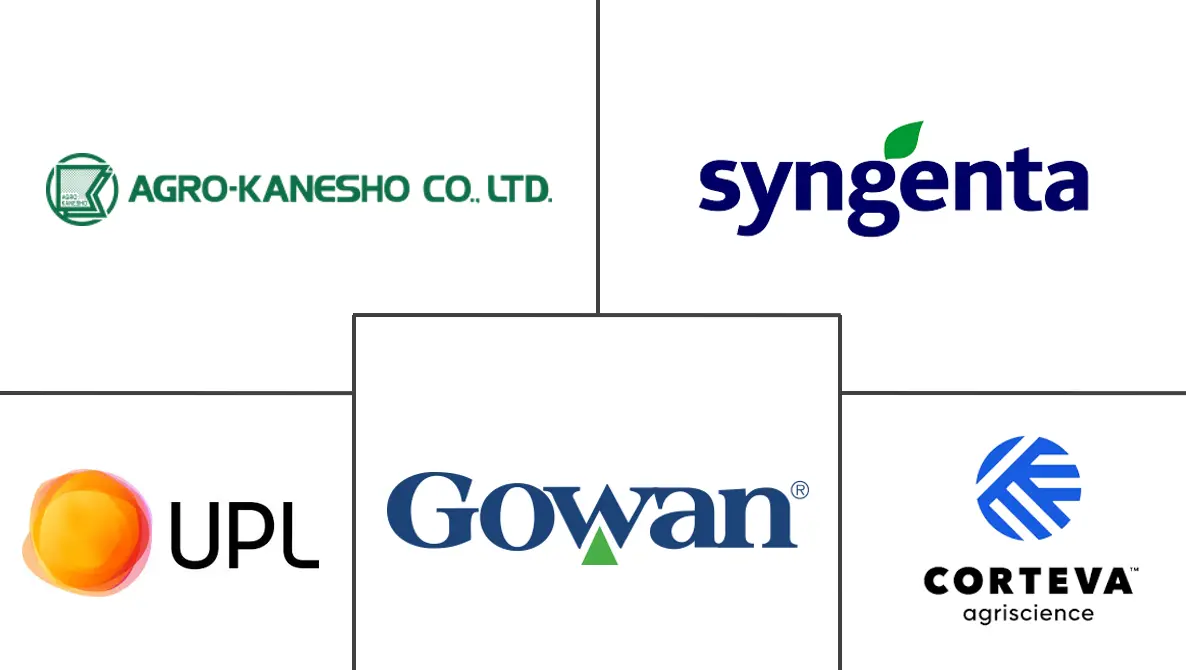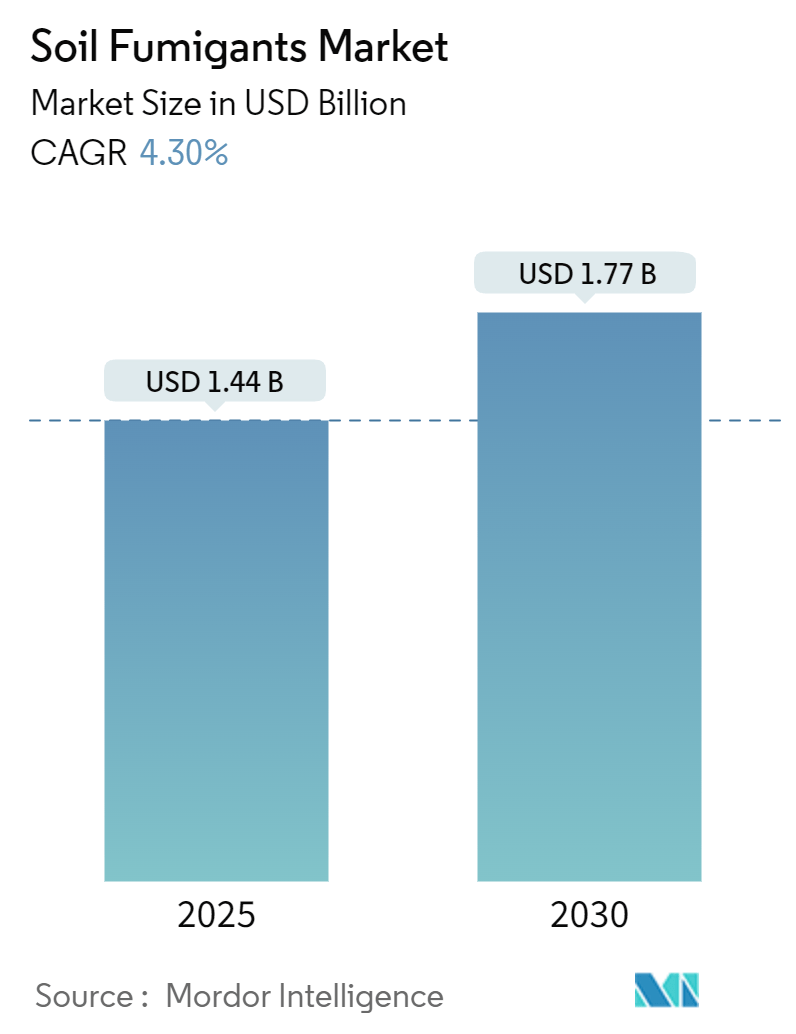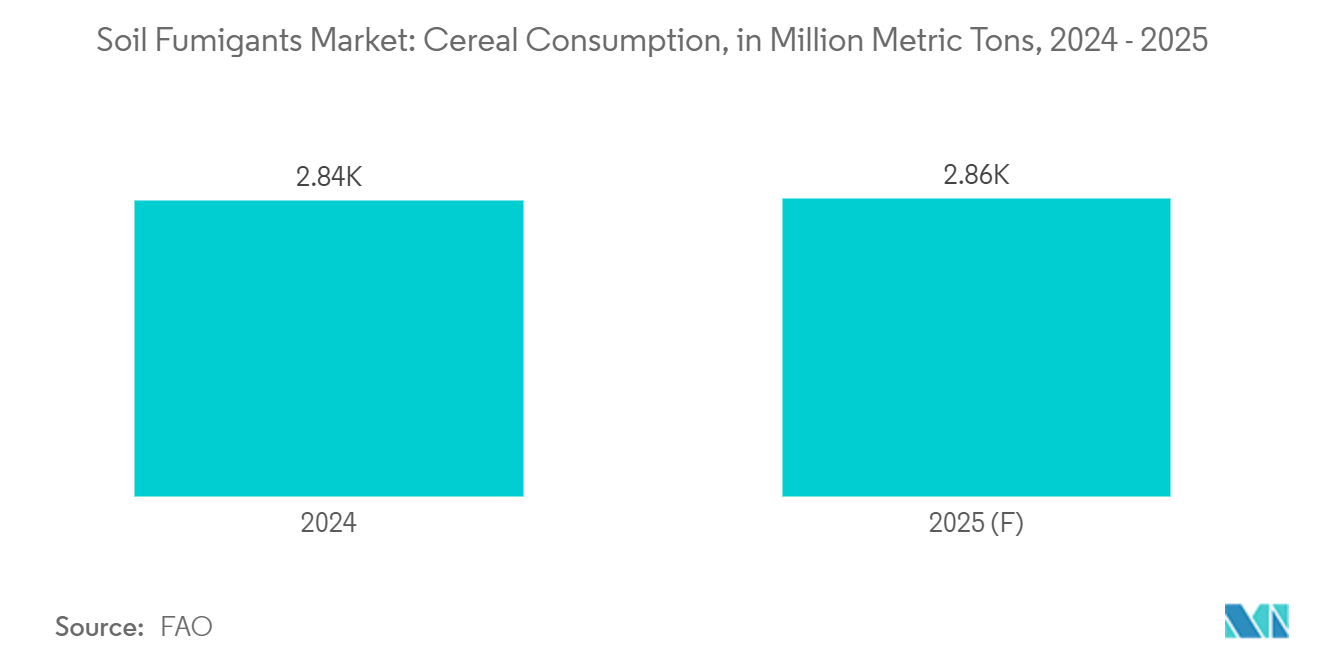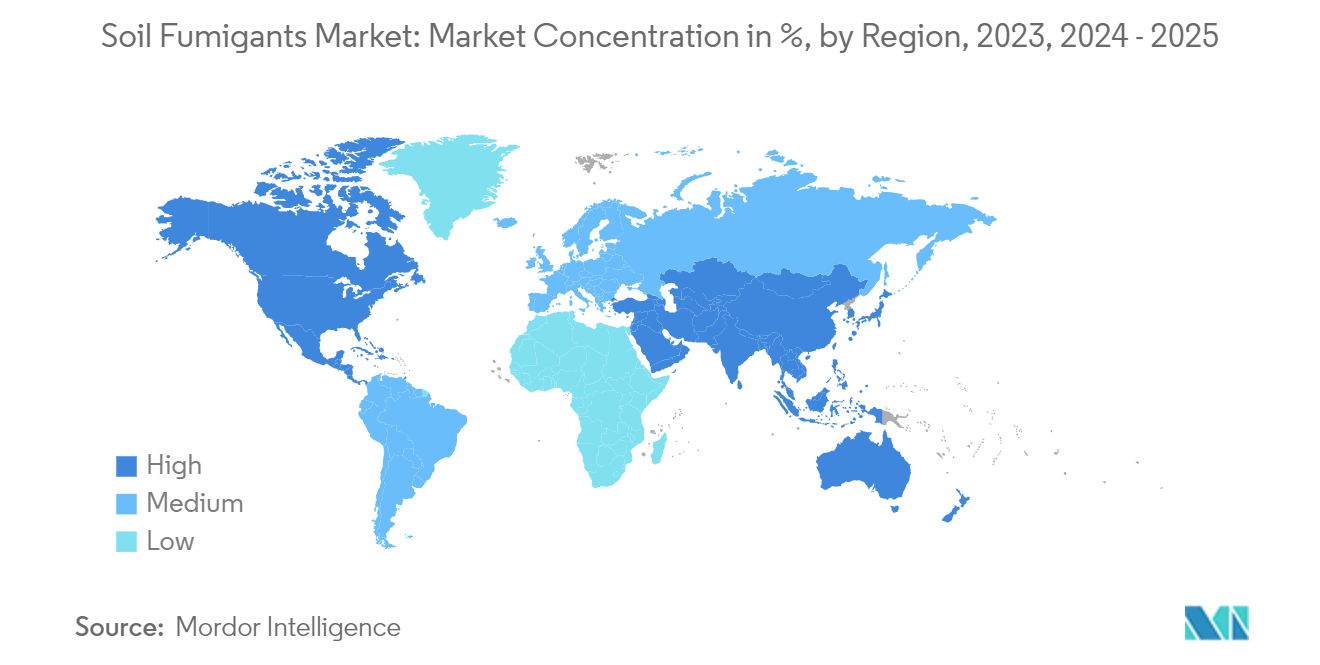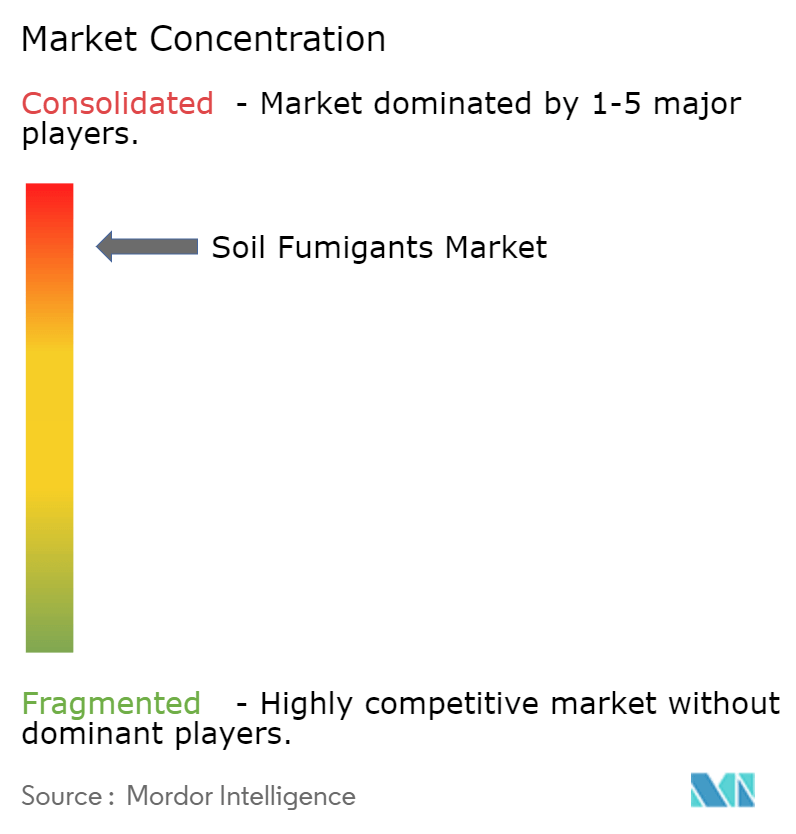Soil Fumigants Market Analysis
The Soil Fumigants Market size is estimated at USD 1.44 billion in 2025, and is expected to reach USD 1.77 billion by 2030, at a CAGR of 4.30% during the forecast period (2025-2030).
The market growth is driven by the high incidence of crop diseases and increasing food demand in both developed and developing nations. The adoption of soil fumigants is projected to rise significantly in the Asia-Pacific and South American regions due to widespread soil-borne crop diseases and expanding vegetable crop production, particularly for tomatoes and potatoes. According to a 2023 study by the Institute of Genetics and Developmental Biology of the Chinese Academy of Sciences, Clubroot, a soil-borne disease, is the most severe threat to Brassica crops. In China, Clubroot affects approximately 3.2 to 4 million hectares of agricultural land annually, causing 20% to 30% yield losses.
The global emphasis on minimizing crop production losses is a key factor driving the soil fumigants market. The need to improve crop productivity to meet rising demand continues to strengthen the market. The United States Environmental Protection Agency identifies the primary soil fumigant pesticide chemicals as chloropicrin, dazomet, 1,3-dichloropropene (telone), dimethyl disulfide (DMDS), and metam sodium. These chemicals are primarily used for pest control in crops such as potato, cucurbit, eggplant, tomato, strawberry, pepper, ornamentals, lettuce, and tobacco.
Soil Fumigants Market Trends
Growing Demand for Food from Developed and Emerging Economies
The Food and Agriculture Organization (FAO) of the United Nations projects agricultural productivity must increase by 70% by 2050 to meet global food demand. With approximately 200,000 people added to the global population daily, ensuring adequate food supply has become a significant challenge. The increasing population pressure, combined with limited arable land resources and changing climate patterns, has intensified the need for effective crop protection measures. This has made the application of soil fumigants an essential practice in global agriculture to maximize yield potential and ensure food security.
Pest infestations, including insects, mites, and rodents, cause damage to approximately 1,300 million metric tons of crops annually. The FAO estimates that pests destroy up to 40% of global crop production each year. Plant diseases result in economic losses exceeding USD 220 billion globally, while invasive insects cause damages of at least USD 70 billion annually. These substantial losses affect not only farm productivity but also threaten food security and agricultural sustainability, necessitating increased soil fumigant usage to protect valuable crops and maintain agricultural output.
FAO forecasts world cereal utilization to reach 2,859 million metric tons in 2024-2025, representing a 0.6% increase from 2023-2024. This growing demand for food grains is driving global production expansion across major agricultural regions. The pressure to increase yields while protecting crops from soil-borne pathogens, nematodes, and other pests has intensified. To maintain production levels and minimize pest impact, the demand for soil fumigants is projected to increase in the coming years, particularly in regions with intensive agriculture and high-value crop production.
Asia Pacific Dominates the Market
The Asia-Pacific region dominates the global soil fumigants market and is projected to experience the fastest growth during the forecast period. The region's prominence in the market stems from its position as the world's largest producer of fruits and vegetables. According to the Department of Commerce, Ministry of Commerce and Industry, Government of India, India ranked as the second-largest producer of fruits and vegetables globally after China in 2023. The market growth is driven by the high consumption of aluminum phosphide, a major fumigant primarily manufactured and exported from China and India.
Several regional characteristics contribute to the sustained use of soil fumigants in Asia-Pacific. The region's high population density, large number of marginal farmers, and limited biological product market create conditions that favor traditional fumigation methods. The pressing need to maintain agricultural production levels has resulted in a gradual transition towards biological alternatives. The widespread regulatory compliance of existing soil fumigants across most Asia-Pacific countries indicates continued market expansion.
The Department of Science and Technology, Government of India, reports that changing climate patterns are increasing the prevalence of soil-borne pathogens, such as those causing dry root rot in chickpeas. According to the World Meteorological Organization (WMO) report published in 2024, Asia experienced the highest number of weather, climate, and water-related disasters globally in 2023, with floods and storms causing significant casualties and economic losses, while heatwave impacts intensified. In Japan, the agricultural sector focuses on sustainable practices, with major industry participants developing alternatives to methyl bromide, particularly for vegetable cultivation. These crop-specific programs emphasize pre-planting treatments, gradually replacing methyl bromide soil fumigation with alternative solutions.
Soil Fumigants Industry Overview
The global fumigants market is consolidated, with a small number of companies holding significant market share. Companies in the soil fumigant segment focus on developing new products and technologies to enhance quality. The major companies in the market include Corteva Agriscience, Syngenta AG, Agro Kanesho Co. Ltd., Gowan Company, and UPL Limited.
Soil Fumigants Market Leaders
-
Syngenta Ag
-
UPL Limited
-
Gowan Company
-
Corteva Agriscience
-
Agro Kanesho Co.,Ltd.
- *Disclaimer: Major Players sorted in no particular order
Soil Fumigants Market News
- January 2024: Syngenta introduced Root Eco Brand, an advanced rhizosphere management system that combines chemicals, biological agents, and nutritional compounds to optimize root systems. The system addresses challenges such as successive cropping obstacles, soil-borne diseases, and root-knot nematode damage in continuous cropping systems.
- June 2023: MustGrow Biologics Corp formed a partnership with Bio Ag Product Strategies to develop and commercialize soil amendment and biofertility technologies. The collaboration includes the development of a pre-plant soil fumigation product.
- June 2023: Syngenta AG introduced Equento, a product that controls soil pests and enhances the sustainability of farming operations.
Soil Fumigants Industry Segmentation
Soil fumigants are chemicals applied to soil to control soil-borne pests, including nematodes, fungi, bacteria, weeds, and insects. The soil fumigants market analysis covers Type (Methyl Bromide, Chloropicrin, Methyl Iodide, Dimethyl Disulfide, and Other Types), Form (Solid, Liquid, and Gaseous), and Geography (North America, Europe, Asia-Pacific, South America, and Africa). The market size is presented in USD Million for all segments.
| Type | Methyl Bromide | ||
| Chloropicrin | |||
| Methyl Iodide | |||
| Dimethyl Disulfide | |||
| Other Types | |||
| Form | Solid | ||
| Liquid | |||
| Gaseous | |||
| Geography | North America | United States | |
| Canada | |||
| Mexico | |||
| Rest of North America | |||
| Europe | Germany | ||
| United Kingdom | |||
| France | |||
| Spain | |||
| Italy | |||
| Rest of Europe | |||
| Asia-Pacific | China | ||
| Japan | |||
| India | |||
| Australia | |||
| Rest of Asia-Pacific | |||
| South America | Brazil | ||
| Argentina | |||
| Rest of South America | |||
| Africa | South Africa | ||
| Rest of Africa | |||
Soil Fumigants Market Research FAQs
How big is the Soil Fumigants Market?
The Soil Fumigants Market size is expected to reach USD 1.44 billion in 2025 and grow at a CAGR of 4.30% to reach USD 1.77 billion by 2030.
What is the current Soil Fumigants Market size?
In 2025, the Soil Fumigants Market size is expected to reach USD 1.44 billion.
Who are the key players in Soil Fumigants Market?
Syngenta Ag, UPL Limited, Gowan Company, Corteva Agriscience and Agro Kanesho Co.,Ltd. are the major companies operating in the Soil Fumigants Market.
Which is the fastest growing region in Soil Fumigants Market?
Asia Pacific is estimated to grow at the highest CAGR over the forecast period (2025-2030).
Which region has the biggest share in Soil Fumigants Market?
In 2025, the Asia Pacific accounts for the largest market share in Soil Fumigants Market.
What years does this Soil Fumigants Market cover, and what was the market size in 2024?
In 2024, the Soil Fumigants Market size was estimated at USD 1.38 billion. The report covers the Soil Fumigants Market historical market size for years: 2020, 2021, 2022, 2023 and 2024. The report also forecasts the Soil Fumigants Market size for years: 2025, 2026, 2027, 2028, 2029 and 2030.

